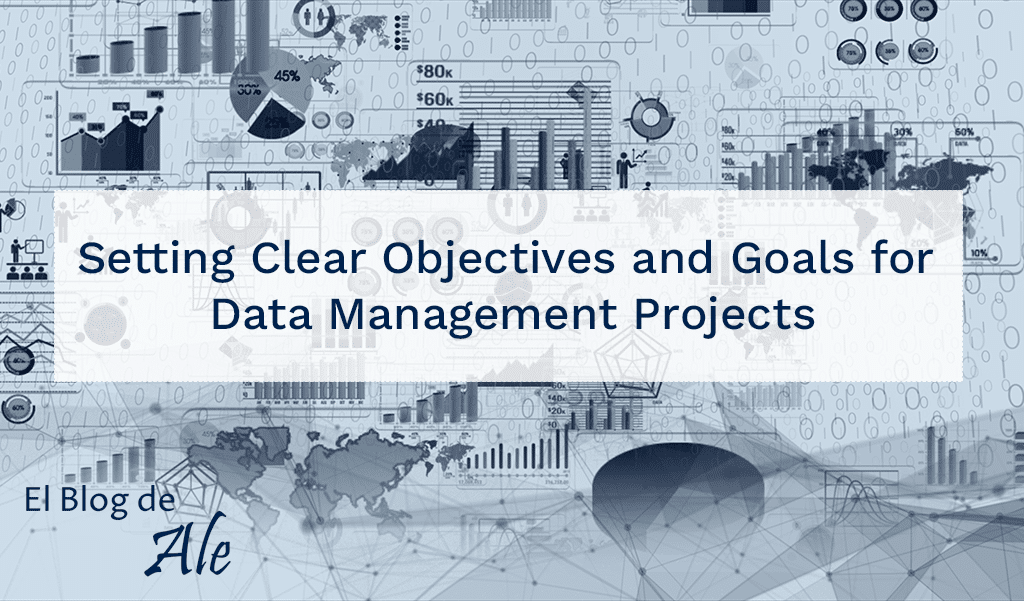Introduction
In today’s data-driven world, organizations across industries recognize the importance of effective data management in driving success and innovation. However, embarking on a data management project without clearly defined objectives and goals can lead to ambiguity, inefficiency, and ultimately, failure to achieve desired outcomes. In this article, we’ll explore the significance of defining objectives and goals for data management projects and provide actionable insights for setting them effectively.

Why Define Objectives and Goals?
Before diving into the complexities of data management, it’s important to establish a clear vision of what you aim to achieve. Defining objectives and goals provides a roadmap for your data management project, guiding decision-making, resource allocation, and prioritization of efforts. Moreover, clear objectives enable stakeholders to align their efforts, measure progress, and evaluate success effectively.
Key Considerations for Defining Objectives and Goals
Business Alignment
Ensure that your objectives and goals align with overarching business strategies and priorities. Identify how improved data management will contribute to achieving organizational objectives, whether it’s enhancing operational efficiency, optimizing decision-making, or driving innovation.
Specificity and Clarity
Define objectives that are specific, measurable, achievable, relevant, and time-bound – SMART -. Avoid vague or ambiguous goals by clearly articulating what you intend to accomplish and how success will be measured. For example, instead of stating a general goal like “improve data quality,” specify measurable metrics such as “reduce data entry errors by 20% within six months.”
Stakeholder Involvement
Involve key stakeholders from various departments and levels of the organization in the goal-setting process. Collaborative discussions ensure that objectives are comprehensive, relevant, and reflective of diverse perspectives and priorities. Additionally, gaining buy-in from stakeholders fosters a sense of ownership and commitment to project success.
Risk Assessment
Consider potential risks and challenges that may impact the achievement of your objectives. Anticipate obstacles such as data governance issues, resource constraints, or technological limitations, and develop mitigation strategies to address them proactively. Identifying risks early allows you to incorporate contingency plans into your project roadmap and minimize disruption to progress.
Examples of Objectives and Goals for Data Management Projects
Those are pillars that must be executed in a Data Management
Improve Data Quality Enhance the accuracy, completeness, and consistency of data across systems and processes to ensure reliability and trustworthiness for decision-making.
Consider to use a well-know Data Quality solution, which should include consultancy, and experience in Data Quality.
Enhance Data Accessibility Increase the availability and accessibility of data to authorized users, enabling timely access to relevant information for analysis and decision-making.
Accessible data fuels innovation by enabling employees to explore new ideas, experiment with data-driven solutions, and develop innovative products and services. When data is readily available, employees are more likely to explore data analytics, machine learning, and other advanced technologies to drive business innovation and differentiation.
Continue reading: Be Ready for the Future: How to Prepare a Data Management Strategy for Artificial Intelligence
Optimize Data Governance Establish robust governance frameworks, policies, and procedures to ensure compliance with regulatory requirements, mitigate risks, and maintain data integrity and security.
Data governance streamlines data management processes and workflows, leading to increased operational efficiency and productivity. By defining roles, responsibilities, and workflows for data management activities, organizations can reduce duplication of efforts, minimize errors, and optimize resource allocation.
Enable Data-driven Insights Empower stakeholders with actionable insights derived from data analytics, enabling informed decision-making, strategic planning, and performance optimization.
Data-driven insights provide decision-makers with valuable information and analytics that they can use to make informed decisions. By leveraging data to gain insights into customer behavior, market trends, and business performance, organizations can make strategic decisions that drive growth, innovation, and competitive advantage.
Streamline Data Integration Simplify and automate the integration of disparate data sources, enabling seamless data flows and interoperability across systems and applications.
Efficient data integration enables organizations to adapt quickly to changing business needs and market dynamics. By streamlining data integration processes and reducing dependencies on manual interventions, organizations can improve agility and responsiveness, allowing them to capitalize on new opportunities and address emerging challenges more effectively.
Reduce Time-to-Insight Minimize the time and effort required to extract, transform, and analyze data, accelerating the delivery of insights and driving agility and responsiveness in decision-making processes.
Conclusion
Defining objectives and goals is a critical first step in any data management project, providing clarity, direction, and purpose to your efforts. By aligning objectives with business priorities, ensuring specificity and clarity, engaging stakeholders, and addressing potential risks, organizations can lay the groundwork for successful data management initiatives. Embrace the power of well-defined objectives to drive innovation, optimize performance, and unlock the transformative potential of data in your organization.

3 thoughts on “Setting Clear Objectives and Goals for Data Management Projects”
Comments are closed.